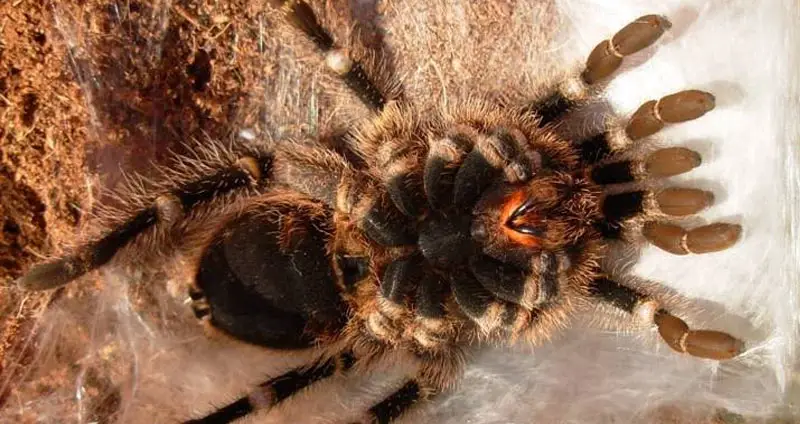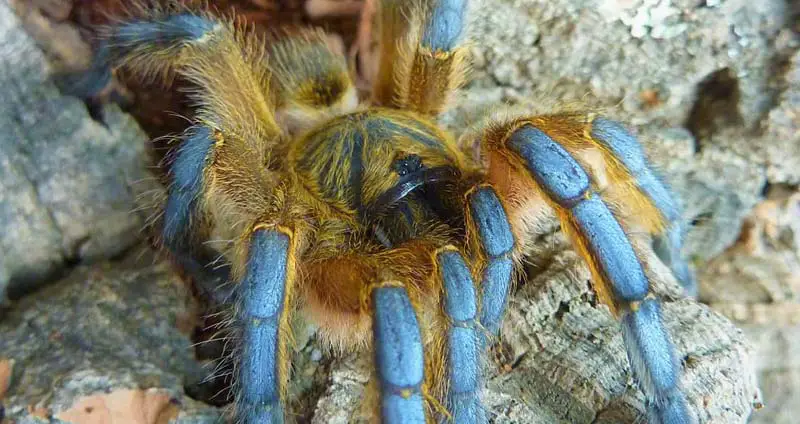Over the years, some tarantulas emerge as favorites, or “crown jewels” among tarantula enthusiasts. Harpactira pulchripes is one of those well-received species, and it’s quite clear why that is.
Their brilliant appearance combined with their rarity made them a status symbol for quite a few years, fetching upwards of $1000 when they first became known. Now, these tarantulas are a bit more common, but that doesn’t make them any less of an incredible specimen.
If you’re thinking about bringing one of these tarantulas into your home, there’s a few pieces of information regarding their appearance, temperament, and general care that you should be aware of.
This post will cover all of those things and help you truly understand the splendor of this species.
Table of Contents
Harpactira pulchripes Care Sheet
Common Name
|
Golden Blue Leg Baboon |
Species Type |
Old world terrestrial |
Habitat |
Found in Makhanda – a populous town in the Eastern Cape province of South Africa. It typically sees temperatures between 50°F and 75°F and average levels of humidity. |
Growth Rate |
Medium growth rate. Males and females reach their maximum size within a couple of years. |
Adult Size |
Females reach a legspan of around 5″, with males measuring slightly smaller. |
Lifespan |
Females regularly live to 12 years, while males often only live to 3 years. |
Enclosure |
The enclosure needs a lot more floor space than vertical height. Several inches of substrate should be provided to allow for deep burrows. The enclosure should also contain a hide and a water bowl. |
Temp/Humidity |
75°F to 80°F with about 60% to 70% humidity. |
Diet |
Great eaters with large appetites. Adults can eat several adult crickets per week or one adult dubia roach. Surprisingly don’t grow very large for having such big appetites. |
Temperament |
Not super aggressive for a baboon tarantula, but still not friendly. Can deliver a very painful bite when threatened. However, it spends most of its time lounging inside its burrow. |
Experience Level |
Intermediate – One of the easier baboon tarantula species to care for as it’s not overly-aggressive. However, it can still be dangerous to care for, and beginners would be in over their heads |
Average Cost |
Slings ~ $80, Males ~ $150, Females ~ $200+ |
Harpactira pulchripes Appearance
The Golden Blue Leg Baboon tarantula has an appearance that’s very unique and quite true to its name.
It features a range of colors from orange to gold to brown to black with the typical black markings of a baboon tarantula on its abdomen and carapace.
This beautiful range of colors is heavily accented by the brilliant ash blue and silver legs poking out from its body. Overall, this is a stunning tarantula to look at, making it a must-have for tarantula collections of all sizes.
Aside from the colors, the appearance of Harpactira pulchripes isn’t too different from other baboon tarantulas. Adults typically grow to have a legspan around 5″ or less, and their growth rate to this point is right about average for a tarantula.
Unlike many other tarantulas, spiderlings of this species tend to already have pronounced colors and patterns that only get more distinct as they age out of their spiderling stage and undergo a few molts.

Harpactira pulchripes Temperament
When you purchase this tarantula, you aren’t only getting one with a unique appearance, but you’re also getting an interesting personality, too.
While they certainly aren’t beginner-friendly tarantulas, they do differ slightly from other baboon species.
Harpactira pulchripes are old world tarantulas found in a small area of Makhanda, South Africa. Old world tarantulas are from the Eastern Hemisphere and are known for their aggressive personalities, quick movements, and painful bite.
Baboon tarantulas can be especially nasty at times. Overall, this is a kind of tarantula that is not meant for beginner tarantula keepers and should never be handled. It’s kept as tarantula that you simply observe, appreciate, and leave alone.
Like essentially all other baboon tarantulas, Harpactira pulchripes are a fossorial species that spend a good portion of their time in their burrow.
Most owners state that their H. pulchripes are more mellow than most other baboon tarantula species that they’ve kept. They aren’t as quick to attack and will spend a bit more time outside of their burrow just relaxing.
However, they are still old world tarantulas, and this means they are capable of delivering quite a painful bite if they feel threatened. For experienced tarantula owners, though, this is a small price to pay for owning such a unique tarantula.
Housing Harpactira pulchripes
If you’re looking into bringing home a Golden Blue Leg Baboon tarantula, you first need to make sure that you can meet its environmental needs.
Additionally, since you won’t want to access a Harpactira pulchripes enclosure very frequently, you should create an environment that doesn’t need to be tweaked or changed much at all.
Optimal Enclosure
While Harpactira pulchripes have special requirements for their enclosure, those requirements aren’t difficult to meet. To begin with, these are terrestrial tarantulas, and like other baboon species they’re obligate burrowers.
Because of this, their enclosure should have a good amount of floor space and depth to it to allow them to create an optimal burrow. They’re also quite heavy webbers, so be sure to include several anchor points for them to attach their webs to.
For a single adult specimen, an enclosure that’s similar to this Exo Terra 18″ x 18″ x 12″ glass terrarium would work excellently. This enclosure provides plenty of floor space for burrowing, is tall enough to prevent a tarantula from bolting, and has a front access door.
Enclosure Decorations
Inside the enclosure, you should offer several amenities including a small water bowl, some sphagnum moss for moisture-retention, a hide for shelter, and a couple of accessories such as rocks and fake plants.
Additionally, it’s very important that you supply your tarantula with about 6-7 inches of high-quality, moisture-retaining substrate.
This substrate not only provides a good burrowing medium, but it also works to keep the enclosure clean and maintain humidity levels.
Most Harpactira pulchripes should have no trouble burrowing through this substrate, but be sure to observe them during their first couple of days to ensure that no problems occur.

Enclosure Temperature/Humidity
In determining the optimal temperature and humidity for this species, it helps to understand its natural environment.
Makhanda is a populous town in the Eastern Cape province of South Africa. It typically sees temperatures between 50°F and 75°F and fairly average levels of humidity.
While Harpactira pulchripes encounters fairly cool temperatures in the wild, they’re safely kept in enclosures that are between 75°F and 80°F. For most people, this is around room temperature.
If your house gets much colder than this, you may need to provide supplemental heating through either a space heater or a gentle heat lamp that doesn’t emit light.
Additionally, the humidity of this species’ natural environment is quite average. So, a terrarium humidity of between 60% and 70% is perfectly acceptable.
This can easily be maintained by monitoring the enclosure with a simple hygrometer and spraying the substrate and webbing with some water when the humidity starts to drop too low.
Diet
This species of tarantula grows at a pretty average rate into a stunning specimen with brilliant, unique colors. In order to make this transformation, though, it requires a nutritious and consistent diet.
Fortunately this species is very easy to feed, and they tend to thrive off of a diet of crickets, roaches, and mealworms.
Many owners find that their Harpactira pulchripes are great eaters with more prominent appetites than most other species. A juvenile specimen (2-3″) can be fed medium-sized crickets twice a week, while fully-grown adults can get upgraded to larger crickets.
Despite their voracious appetites, these tarantulas don’t tend to get as plump as others that have similar diets.
Health Concerns
Captive tarantulas don’t tend to experience many health issues. When they’re supplied with a safe and appropriate enclosure with a healthy diet, there aren’t many things that can go wrong.
The two most common issues that captive tarantulas run into are dehydration and mites/parasites, but both of those problems are easy to avoid and cure.
There are two important things to note when it comes to Harpactira pulchripes. First of all, they absolutely need to be able to create a burrow. This burrow is where they’ll spend most of their time and where they’ll feel safe.
If they’re not able to create a burrow, they may start exhibiting strange behavior that could turn destructive.
Secondly, some tarantulas can run into issues with their molt. While most tarantulas don’t have any problems completing their molt, come may get stuck. In this case, you’ll need to undergo the dangerous but necessary task of helping your tarantula remove their exoskeleton.
If this happens to your tarantula, there are many guides online that help you with this task.
Harpactira pulchripes For Sale & Price
As stated, Harpactira pulchripes was a very hot and sought-after tarantula several years ago. It was very difficult to acquire and looks phenomenal, so this resulted in quite an expensive species.
Towards the beginning, .5″ spiderlings were selling for just around $500 — a price that drove most people away. Fortunately, as time has gone on and more breeders have access to these tarantulas, the price has come way down.
You can find these tarantulas on on various marketplace websites for between $80 and $100 for a healthy spiderling with safe arrival insurance. While this is way cheaper than they were several years ago, the price may even continue to drop. However, this price range is very reasonable for such an interesting and attractive baboon tarantula.
So, for under $100 you can own a tarantula that was originally selling for several hundred a pop just a few years ago. For an old world tarantula, Harpactira pulchripes is decently calm, and it has an appearance that many people find incredible.
With an average female lifespan of 10 to 12 years, Golden Blue Leg Baboons can provide their owners with years of entertainment in their collection.

